Annealing Temperature Effects of Seeded ZnO Thin Films on Efficiency of Photocatalytic and Photoelectrocatalytic Degradation of Tetracycline Hydrochloride in Water
Abstract
:1. Introduction
2. Results and Discussion
2.1. XRD Analysis for Z-ZnO Thin Films
2.2. UV-Vis Absorption Spectra
2.3. SEM Analysis
2.4. Photocatalytic Performance
2.4.1. Effect of Annealing Temperature
2.4.2. Effect of Seeding Layer
2.5. Compression Between Photocatalytic and Photoelectrocatalytic Performance
3. Materials and Methods
3.1. Materials
3.2. Pretreatment of FTO Glass
3.3. Seeding Layer and Electrodeposition of ZnO Layer
3.4. Photocatalysis Performance
3.5. Photoelectrocatalysis Performance
3.6. Characterization of Z-ZnO
4. Conclusions
Author Contributions
Funding
Data Availability Statement
Acknowledgments
Conflicts of Interest
References
- Xiao, H.; Wang, Y.; Peng, H.; Zhu, Y.; Fang, D.; Wu, G.; Li, L.; Zeng, Z. Highly Efficient Degradation of Tetracycline Hydrochloride in Water by Oxygenation of Carboxymethyl Cellulose-Stabilized FeS Nanofluids. Int. J. Environ. Res. Public Health 2022, 19, 11447. [Google Scholar] [CrossRef]
- Fang, Z.; Jiang, H.; Gong, J.; Zhang, H.; Hu, X.; Ouyang, K.; Guo, Y.; Hu, X.; Wang, H.; Wang, P. Removal of Tetracycline Hydrochloride from Water by Visible-Light Photocatalysis Using BiFeO3/BC Materials. Catalysts 2022, 12, 1461. [Google Scholar] [CrossRef]
- Hain, E.; Adejumo, H.; Anger, B.; Orenstein, J.; Blaney, L. Advances in Antimicrobial Activity Analysis of Fluoroquinolone, Macrolide, Sulfonamide, and Tetracycline Antibiotics for Environmental Applications through Improved Bacteria Selection. J. Hazard. Mater. 2021, 415, 125686. [Google Scholar] [CrossRef]
- Wang, K.; Wu, J.; Zhu, M.; Zheng, Y.Z.; Tao, X. Highly Effective PH-Universal Removal of Tetracycline Hydrochloride Antibiotics by UiO-66-(COOH)2/GO Metal–Organic Framework Composites. J. Solid State Chem. 2020, 284, 121200. [Google Scholar] [CrossRef]
- Byrne, C.; Subramanian, G.; Pillai, S.C. Recent Advances in Photocatalysis for Environmental Applications. J. Environ. Chem. Eng. 2018, 6, 3531–3555. [Google Scholar] [CrossRef]
- Mohamed, H.H.; Wazan, G.; Besisa, D.H.A. Natural Clay Minerals as Heterojunctions of Multi-Metal Oxides for Superior Photocatalytic Activity. Mater. Sci. Eng. B 2022, 286, 116077. [Google Scholar] [CrossRef]
- Qian, W.; Hu, W.; Jiang, Z.; Wu, Y.; Li, Z.; Diao, Z.; Li, M. Degradation of Tetracycline Hydrochloride by a Novel CDs/g-C3N4/BiPO4 under Visible-Light Irradiation: Reactivity and Mechanism Wei. Catalysts 2022, 12, 774. [Google Scholar] [CrossRef]
- Lv, Y.; Gong, Z.; Ren, Z.; Guan, Y.; Wu, J.; Lv, K. Photocatalytic Degradation of Tetracycline Hydrochloride by Zinc oxide/Polypyrrole/Carbon nanotubes. ChemistrySelect 2023, 8, e202204762. [Google Scholar] [CrossRef]
- Luu, T.V.H.; Nguyen, H.Y.X.; Nguyen, Q.T.; Nguyen, Q.B.; Nguyen, T.H.C.; Pham, N.C.; Nguyen, X.D.; Nguyen, T.K.; Dao, N.N. Enhanced Photocatalytic Performance of ZnO under Visible Light by Co-Doping of Ta and C Using Hydrothermal Method. RSC Adv. 2024, 14, 12954–12965. [Google Scholar] [CrossRef] [PubMed]
- El Golli, A.; Contreras, S.; Dridi, C. Bio-Synthesized ZnO Nanoparticles and Sunlight-Driven Photocatalysis for Environmentally-Friendly and Sustainable Route of Synthetic Petroleum Refinery Wastewater Treatment. Sci. Rep. 2023, 13, 20809. [Google Scholar] [CrossRef] [PubMed]
- Ahmad, I.; Bousbih, R.; Mahal, A.; Khan, W.Q.; Aljohani, M.; Jafar, N.N.; Jabir, M.S.; Majdi, H.; Alshomrany, A.S.; Shaban, M.; et al. Recent Progress in ZnO-Based Heterostructured Photocatalysts: A Review. Mater. Sci. Semicond. Process. 2024, 180, 108578. [Google Scholar] [CrossRef]
- Cheng, F.; Liang, L.; Lin, G.; Xi, S. Enhanced Photoelectrocatalysis in Porous Single Crystalline Rutile Titanium Dioxide Electrodes. J. Mater. Chem. A 2024, 12, 3879–3885. [Google Scholar] [CrossRef]
- Goutham, R.; Badri Narayan, R.; Srikanth, B.; Gopinath, K.P. Supporting Materials for Immobilisation of Nano-Photocatalysts; Springer: Berlin/Heidelberg, Germany, 2019; ISBN 9783030106096. [Google Scholar]
- Elias, M.; Uddin, M.N.; Saha, J.K.; Hossain, M.A.; Sarker, D.R.; Akter, S.; Siddiquey, I.A.; Uddin, J. A Highly Efficient and Stable Photocatalyst; N-Doped ZnO/CNT Composite Thin Film Synthesized via Simple Sol-Gel Drop Coating Method. Molecules 2021, 2, 1470. [Google Scholar] [CrossRef] [PubMed]
- Elias, M.; Amin, M.K.; Firoz, S.H.; Hossain, M.A.; Akter, S.; Hossain, M.A.; Uddin, M.N.; Siddiquey, I.A. Microwave-Assisted Synthesis of Ce-Doped ZnO/CNT Composite with Enhanced Photo-Catalytic Activity. Ceram. Int. 2017, 43, 84–91. [Google Scholar] [CrossRef]
- AlMohamadi, H.; Awad, S.A.; Sharma, A.K.; Fayzullaev, N.; Távara-Aponte, A.; Chiguala-Contreras, L.; Amari, A.; Rodriguez-Benites, C.; Tahoon, M.A.; Esmaeili, H.P. Photocatalytic Activity of Metal- and Non-Metal-Anchored ZnO and TiO2 Nanocatalysts for Advanced Photocatalysis: Comparative Study. Catalysts 2024, 14, 420. [Google Scholar] [CrossRef]
- Priyadharsan, A.; Ranjith, R.; Karmegam, N.; Thennarasu, G.; Ragupathy, S.; Oh, T.H.; Ramasundaram, S. Effect of Metal Doping and Non-Metal Loading on Light Energy Driven Degradation of Organic Dye Using ZnO Nanocatalysts. Chemosphere 2023, 330, 138708. [Google Scholar] [CrossRef] [PubMed]
- Vallarasu, K.; Dinesh, S.; Nantha kumar, M.; Mithun, D.; Anitha, R.; Vijayalakshmi, V. ZnO Heterojunction Photocatalysts Prepared via Facile Green Synthesis Process Attaining Improved Photocatalytic Function for Degradation of Methylene Blue Dye. Desalin. Water Treat. 2024, 318, 100391. [Google Scholar] [CrossRef]
- Chaudhary, D.; Singh, S.; Vankar, V.D.; Khare, N. ZnO Nanoparticles Decorated Multi-Walled Carbon Nanotubes for Enhanced Photocatalytic and Photoelectrochemical Water Splitting. J. Photochem. Photobiol. A Chem. 2018, 351, 154–161. [Google Scholar] [CrossRef]
- Ossai, A.N.; Alabi, A.B.; Ezike, S.C.; Aina, A.O. Zinc Oxide-Based Dye-Sensitized Solar Cells Using Natural and Synthetic Sensitizers. Curr. Res. Green Sustain. Chem. 2020, 3, 100043. [Google Scholar] [CrossRef]
- Wudil, Y.S.; Ahmad, U.F.; Gondal, M.A.; Al-Osta, M.A.; Almohammedi, A.; Sa’id, R.S.; Hrahsheh, F.; Haruna, K.; Mohamed, M.J.S. Tuning of Graphitic Carbon Nitride (g-C3N4) for Photocatalysis: A Critical Review. Arab. J. Chem. 2023, 16, 104542. [Google Scholar] [CrossRef]
- Li, Y.; Yan, M.; Li, X.; Ma, J. Construction of Cu2O-ZnO/Cellulose Composites for Enhancing the Photocatalytic Performance. Catalysts 2024, 14, 476. [Google Scholar] [CrossRef]
- Lu, H.; Zhang, M.; Guo, M. Controllable Electrodeposition of ZnO Nanorod Arrays on Flexible Stainless Steel Mesh Substrate for Photocatalytic Degradation of Rhodamine B. Appl. Surf. Sci. 2014, 317, 672–681. [Google Scholar] [CrossRef]
- Ko, Y.H.; Kim, M.S.; Yu, J.S. Structural and Optical Properties of Zno Nanorods by Electrochemical Growth Using Multi-Walled Carbon Nanotubecomposed Seed Layers. Nanoscale Res. Lett. 2012, 7, 1–6. [Google Scholar] [CrossRef] [PubMed]
- Wei, Y.; Du, H.; Kong, J.; Lu, X.; Ke, L.; Sun, X.W. Multi-Walled Carbon Nanotubes Modified ZnO Nanorods: A Photoanode for Photoelectrochemical Cell. Electrochim. Acta 2014, 143, 188–195. [Google Scholar] [CrossRef]
- Elias, M.; Uddin, M.N.; Hossain, M.A.; Saha, J.K.; Siddiquey, I.A.; Sarker, D.R.; Diba, Z.R.; Uddin, J.; Rashid Choudhury, M.H.; Firoz, S.H. An Experimental and Theoretical Study of the Effect of Ce Doping in ZnO/CNT Composite Thin Film with Enhanced Visible Light Photo-Catalysis. Int. J. Hydrogen Energy 2019, 44, 20068–20078. [Google Scholar] [CrossRef]
- Desai, M.A.; Sharma, V.; Prasad, M.; Gund, G.; Jadkar, S.; Sartale, S.D. Photoelectrochemical Performance of MWCNT–Ag–ZnO Ternary Hybrid: A Study of Ag Loading and MWCNT Garnishing. J. Mater. Sci. 2021, 56, 8627–8642. [Google Scholar] [CrossRef]
- Kuwajima, T.; Nakanishi, Y.; Yamamoto, A.; Nobusawa, K.; Ikeda, A.; Tomita, S.; Yanagi, H.; Ichinose, K.; Yoshida, T. Fabrication of Carbon Nanotube/Zinc Oxide Composite Films by Electrodeposition. Jpn. J. Appl. Phys. 2011, 50, 8–11. [Google Scholar] [CrossRef]
- Hong, W.; Meng, M.; Liu, Q. Antibacterial and Photocatalytic Properties of Cu2O/ZnO Composite Film Synthesized by Electrodeposition. Res. Chem. Intermed. 2017, 43, 2517–2528. [Google Scholar] [CrossRef]
- Ren, P.; Deng, H.Y.; Zhang, J.X.; Dai, N. Nucleation Mechanism and Microstructural Analysis of Zn Films on Mo Substrates by Electrodeposition. J. Electrochem. Soc. 2016, 163, D309–D313. [Google Scholar] [CrossRef]
- Kim, W.Y.; Kim, S.W.; Yoo, D.H.; Kim, E.J.; Hahn, S.H. Annealing Effect of ZnO Seed Layer on Enhancing Photocatalytic Activity of ZnO/TiO2 Nanostructure. Int. J. Photoenergy 2013, 2013, 130541. [Google Scholar] [CrossRef]
- Li, C.; Fang, G.; Li, J.; Ai, L.; Dong, B.; Zhao, X. Effect of Seed Layer on Structural Properties of ZnO Nanorod Arrays Grown by Vapor-Phase Transport Effect of Seed Layer on Structural Properties of ZnO Nanorod Arrays Grown by Vapor-Phase Transport. J. Phys. Chem. C 2008, 112, 990–995. [Google Scholar] [CrossRef]
- Wang, S.F.; Tseng, T.Y.; Wang, Y.R.; Wang, C.Y.; Lu, H.C. Effect of ZnO Seed Layers on the Solution Chemical Growth of ZnO Nanorod Arrays. Ceram. Int. 2009, 35, 1255–1260. [Google Scholar] [CrossRef]
- Ait hssi, A.; Atourki, L.; labchir, N.; Ouafi, M.; Abouabassi, K.; Elfanaoui, A.; Ihlal, A.; Bouabid, K. Electrodeposition of Oriented ZnO Nanorods by Two-Steps Potentiostatic Electrolysis: Effect of Seed Layer Time. Solid State Sci. 2020, 104, 106207. [Google Scholar] [CrossRef]
- Wilson Balogun, S. Impact of Post-Deposition Heat Treatment on the Morphology and Optical Properties of Zinc Oxide (ZnO) Thin Film Prepared by Spin-Coating Technique. J. Photonic Mater. Technol. 2017, 3, 20. [Google Scholar] [CrossRef]
- Cheol, W.; Pal, J.; Kim, Y.; Song, J.; Hwa, K.; Seong, T. Effect of Thermal Annealing on the Properties of ZnO Thin Films. Vacuum 2020, 183, 109776. [Google Scholar] [CrossRef]
- Alshoaibi, A. The Influence of Annealing Temperature on the Microstructure and Electrical Properties of Sputtered ZnO Thin Films. Inorganics 2024, 12, 236. [Google Scholar] [CrossRef]
- Haritha, A.H.; Cruz, M.E.; Sisman, O.; Duran, A.; Galusek, D.; Castro, Y.; Ceramics, O.; Cruz, M.E.; Sisman, O.; Duran, A.; et al. Influence of Annealing Temperature on the Photocatalytic Efficiency of Sol-Gel Dip-Coated ZnO Thin Films in Methyl Orange Degradation. OPEN Ceram. 2024, 21, 100727. [Google Scholar] [CrossRef]
- Kang, F.; Sheng, G.; Yang, X.; Zhang, Y. Fabrication of Two-Dimensional Bi2MoO6 Nanosheet-Decorated Bi2MoO6/Bi4O5Br2 Type II Heterojunction and the Enhanced Photocatalytic Degradation of Antibiotics. Catalysts 2024, 12, 289. [Google Scholar] [CrossRef]
- Rayalu, S.S.; Mangrulkar, P.A.; Kamble, S.P.; Joshi, M.M.; Meshram, J.S.; Labhsetwar, N.K. Photocatalytic Degradation of Phenolics by N-Doped Mesoporous Titania under Solar Radiation. Int. J. Photoenergy 2012, 2012, 780562. [Google Scholar] [CrossRef]
- Miceli, M.; Frontera, P.; Macario, A.; Malara, A. Recovery/Reuse of Heterogeneous Supported Spent Catalysts. Catalysts 2021, 11, 591. [Google Scholar] [CrossRef]
- Habibi, M. Highly Impressive Activation of Persulfate Ions by Novel ZnO/CuCo O Nanostructures for Photocatalytic Removal of Tetracycline Hydrochloride under Visible Light. Environ. Technol. Innov. 2021, 24, 102038. [Google Scholar] [CrossRef]
- Liu, D.; Li, H.; Gao, R.; Zhao, Q.; Yang, Z.; Gao, X.; Wang, Z.; Zhang, F.; Wu, W. Enhanced Visible Light Photoelectrocatalytic Degradation of Tetracycline Hydrochloride by I and P Co-Doped TiO2 Photoelectrode. J. Hazard. Mater. 2021, 406, 124309. [Google Scholar] [CrossRef] [PubMed]
- Liu, J.; Zhang, S.; Wang, W.; Zhang, H. Photoelectrocatalytic Principles for Meaningfully Studying Photocatalyst Properties and Photocatalysis Processes: From Fundamental Theory to Environmental Applications. J. Energy Chem. 2023, 86, 84–117. [Google Scholar] [CrossRef]
- Pedanekar, R.S.; Mohite, S.V.; Madake, S.B.; Kim, Y.; Gunjakar, J.L.; Rajpure, K.Y. Photoelectrocatalytic Activity of Methylene Blue Using Chemically Sprayed Bi2WO6 Photoanode under Natural Sunlight. J. Alloys Compd. 2023, 942, 168866. [Google Scholar] [CrossRef]
- Suhadolnik, L.; Pohar, A.; Likozar, B.; Čeh, M. Mechanism and Kinetics of Phenol Photocatalytic, Electrocatalytic and Photoelectrocatalytic Degradation in a TiO2-Nanotube Fixed-Bed Microreactor. Chem. Eng. J. 2016, 303, 292–301. [Google Scholar] [CrossRef]
- Torres-Pinto, A.; Díez, A.M.; Silva, C.G.; Faria, J.L.; Sanromán, M.Á.; Silva, A.M.T.; Pazos, M. Photoelectrocatalytic Degradation of Pharmaceuticals Promoted by a Metal-Free G-C3N4 Catalyst. Chem. Eng. J. 2023, 476, 146761. [Google Scholar] [CrossRef]
- Li, T.; Wang, Z.; Liu, C.; Tang, C.; Wang, X.; Ding, G.; Ding, Y.; Yang, L. TiO2 Nanotubes/Ag/MoS2 Meshy Photoelectrode with Excellent Photoelectrocatalytic Degradation Activity for Tetracycline Hydrochloride. Nanomaterials 2018, 8, 666. [Google Scholar] [CrossRef] [PubMed]
- Slimi, B.; Ben Assaker, I.; Kriaa, A.; Marí, B.; Chtourou, R. One-Step Electrodeposition of Ag-Decorated ZnO Nanowires. J. Solid State Electrochem. 2017, 21, 1253–1261. [Google Scholar] [CrossRef]
- Hezam, F.A.; Nur, O.; Mustafa, M.A. Synthesis, Structural, Optical and Magnetic Properties of NiFe2O4/MWCNTs/ZnO Hybrid Nanocomposite for Solar Radiation Driven Photocatalytic Degradation and Magnetic Separation. Colloids Surfaces A Physicochem. Eng. Asp. 2020, 592, 124586. [Google Scholar] [CrossRef]
- Wang, M.; Zhou, Y.; Zhang, Y.; Hahn, S.H.; Kim, E.J. From Zn(OH)2 to ZnO: A Study on the Mechanism of Phase Transformation. CrystEngComm 2011, 13, 6024–6026. [Google Scholar] [CrossRef]
- Bui, Q.C.; Salem, B.; Roussel, H.; Mescot, X.; Guerfi, Y.; Jiménez, C.; Consonni, V.; Ardila, G. Effects of Thermal Annealing on the Structural and Electrical Properties of ZnO Thin Films for Boosting Their Piezoelectric Response. J. Alloys Compd. 2021, 870, 159512. [Google Scholar] [CrossRef]
- Ahmed, N.M.; Sabah, F.A.; Abdulgafour, H.I.; Alsadig, A.; Sulieman, A.; Alkhoaryef, M. The Effect of Post Annealing Temperature on Grain Size of Indium-Tin-Oxide for Optical and Electrical Properties Improvement. Results Phys. 2019, 13, 102159. [Google Scholar] [CrossRef]
- Kabir, M.H.; Ali, M.M.; Kaiyum, M.A.; Rahman, M.S. Effect of Annealing Temperature on Structural Morphological and Optical Properties of Spray Pyrolized Al-Doped ZnO Thin Films. J. Phys. Commun. 2019, 3, 105007. [Google Scholar] [CrossRef]
- Soonmin, H. Investigation of Optical Properties of Thin Films by Means of UV-Visible Spectrophotometer: A Review. New Front. Phys. Sci. Res. 2022, 5, 66–82. [Google Scholar] [CrossRef]
- Baishya, K.; Ray, J.S.; Dutta, P.; Das, P.P.; Das, S.K. Graphene-Mediated Band Gap Engineering of WO3 Nanoparticle and a Relook at Tauc Equation for Band Gap Evaluation. Appl. Phys. A Mater. Sci. Process. 2018, 124, 704. [Google Scholar] [CrossRef]
- Sabeeh, S.H.; Jassam, R.H. The Effect of Annealing Temperature and Al Dopant on Characterization of ZnO Thin Films Prepared by Sol-Gel Method. Results Phys. 2018, 10, 212–216. [Google Scholar] [CrossRef]
- Caglar, M.; Ilican, S.; Caglar, Y.; Yakuphanoglu, F. Electrical Conductivity and Optical Properties of ZnO Nanostructured Thin Film. Appl. Surf. Sci. 2009, 255, 4491–4496. [Google Scholar] [CrossRef]
- Wang, Y.; Tang, W.; Zhang, L.; Zhao, J. Electron Concentration Dependence of Optical Band Gap Shift in Ga-Doped ZnO Thin Films by Magnetron Sputtering. Thin Solid Films 2014, 565, 62–68. [Google Scholar] [CrossRef]
- Hung-Chun Lai, H.; Basheer, T.; Kuznetsov, V.L.; Egdell, R.G.; Jacobs, R.M.J.; Pepper, M.; Edwards, P.P. Dopant-Induced Bandgap Shift in Al-Doped ZnO Thin Films Prepared by Spray Pyrolysis. J. Appl. Phys. 2012, 112, 83708. [Google Scholar] [CrossRef]
- Dac Dien, N. Preparation of Various Morphologies of ZnO Nanostructure through Wet Chemical Methods. Adv. Mater. Sci. 2019, 4, 1–5. [Google Scholar] [CrossRef]
- Abdel-Fattah, T.M.; Wixtrom, A.; Zhang, K.; Cao, W.; Baumgart, H. Highly Uniform Self-Assembled Gold Nanoparticles over High Surface Area ZnO Nanorods as Catalysts. ECS J. Solid State Sci. Technol. 2014, 3, M61–M64. [Google Scholar] [CrossRef]
- Clabel, H.J.L.; Awan, I.T.; Rivera, V.A.G.; Nogueira, I.C.; Pereira-da-Silva, M.A.; Li, M.S.; Ferreira, S.O.; Marega, E. Growth Process and Grain Boundary Defects in Er Doped BaTiO3 Processed by EB-PVD: A Study by XRD, FTIR, SEM and AFM. Appl. Surf. Sci. 2019, 493, 982–993. [Google Scholar] [CrossRef]
- Lv, J.; Gong, W.; Huang, K.; Zhu, J.; Meng, F.; Song, X.; Sun, Z. Effect of Annealing Temperature on Photocatalytic Activity of ZnO Thin Films Prepared by Sol-Gel Method. Superlattices Microstruct. 2011, 50, 98–106. [Google Scholar] [CrossRef]
- Chen, C.S.; Xie, X.D.; Cao, S.Y.; Liu, T.G.; Lin, L.W.; Chen, X.H.; Liu, Q.C.; Kuang, J.C.; Xiao, Y. Preparation and Photocatalytic Activity of Multi-Walled Carbon Nanotubes/Mg-Doped ZnO Nanohybrids. Mater. Sci. Pol. 2015, 33, 460–469. [Google Scholar] [CrossRef]
- López Guemez, A.d.R.; Cordero García, A.; Cervantes López, J.L.; Pérez Vidal, H.; Díaz Flores, L.L. Evaluation of the Photocatalytic Activity of ZnO Nanorods and Nanoflowers Grown from Seed Layers Deposited by Spin Coating. Bol. La Soc. Esp. Ceram. Y Vidr. 2023, 63, 72–84. [Google Scholar] [CrossRef]
- Ikizler, B.; Peker, S.M. Effect of the Seed Layer Thickness on the Stability of ZnO Nanorod Arrays. Thin Solid Films 2014, 558, 149–159. [Google Scholar] [CrossRef]
- Song, C.; Liu, H.Y.; Guo, S.; Wang, S.G. Photolysis Mechanisms of Tetracycline under UV Irradiation in Simulated Aquatic Environment Surrounding Limestone. Chemosphere 2020, 244, 125582. [Google Scholar] [CrossRef]
- Ait hssi, A.; Amaterz, E.; labchir, N.; Atourki, L.; Bouderbala, I.Y.; Elfanaoui, A.; Benlhachemi, A.; Ihlal, A.; Bouabid, K. Electrodeposited ZnO Nanorods as Efficient Photoanodes for the Degradation of Rhodamine B. Phys. Status Solidi Appl. Mater. Sci. 2020, 217, 2000349. [Google Scholar] [CrossRef]
- Gan, W.Y.; Friedmann, D.; Amal, R.; Zhang, S.; Chiang, K.; Zhao, H. A Comparative Study between Photocatalytic and Photoelectrocatalytic Properties of Pt Deposited TiO2 Thin Films for Glucose Degradation. Chem. Eng. J. 2010, 158, 482–488. [Google Scholar] [CrossRef]
- Rokade, A.; Rondiya, S.; Gabhale, B.; Diwate, K.; Karpe, S.; Mayabadi, A.; Pandharkar, S.; Sharma, V.; Lonkar, G.; Pathan, H.; et al. Electrodeposition of Template Free Hierarchical ZnO Nanorod Arrays via a Chloride Medium. J. Mater. Sci. Mater. Electron. 2016, 27, 12357–12364. [Google Scholar] [CrossRef]

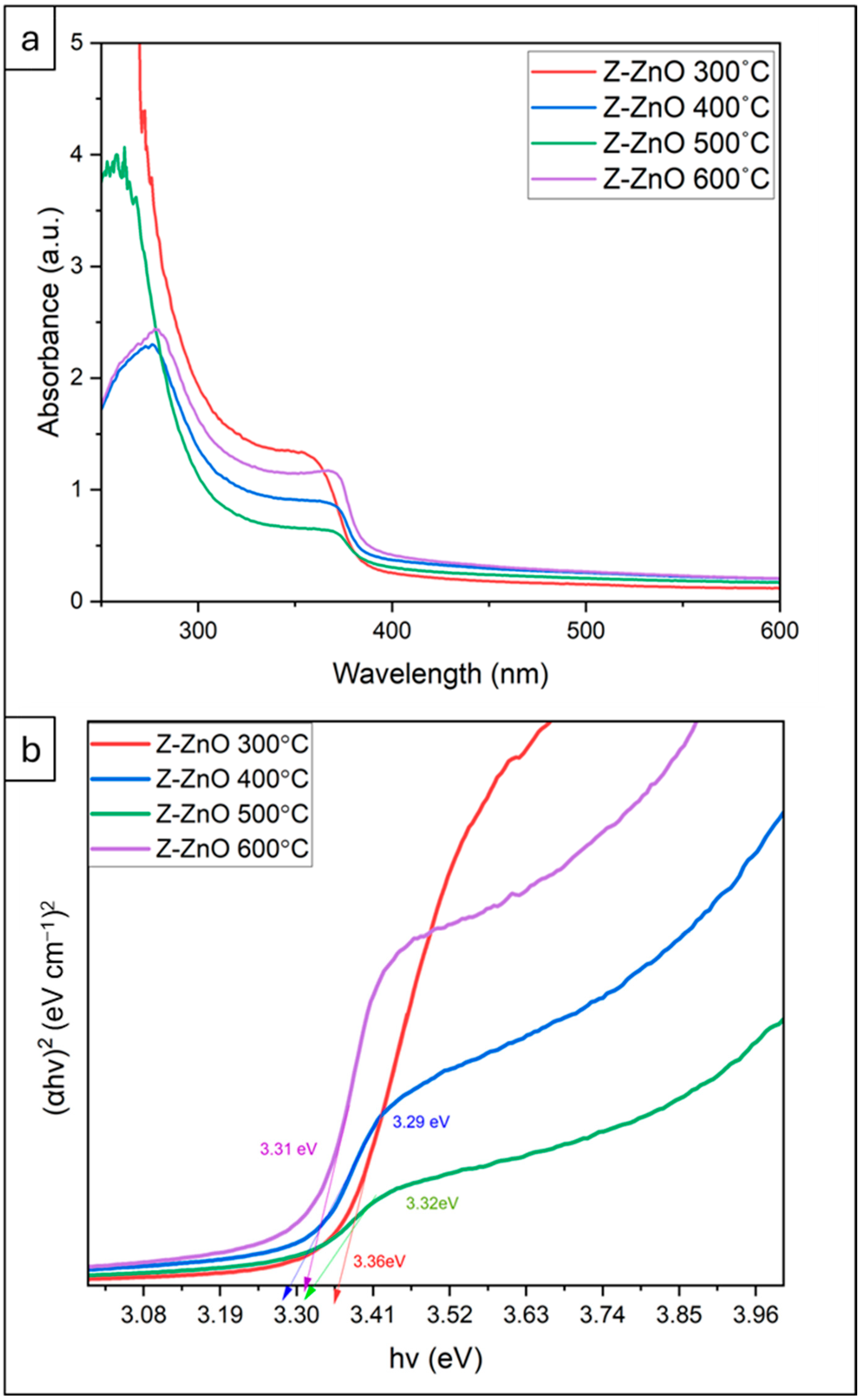
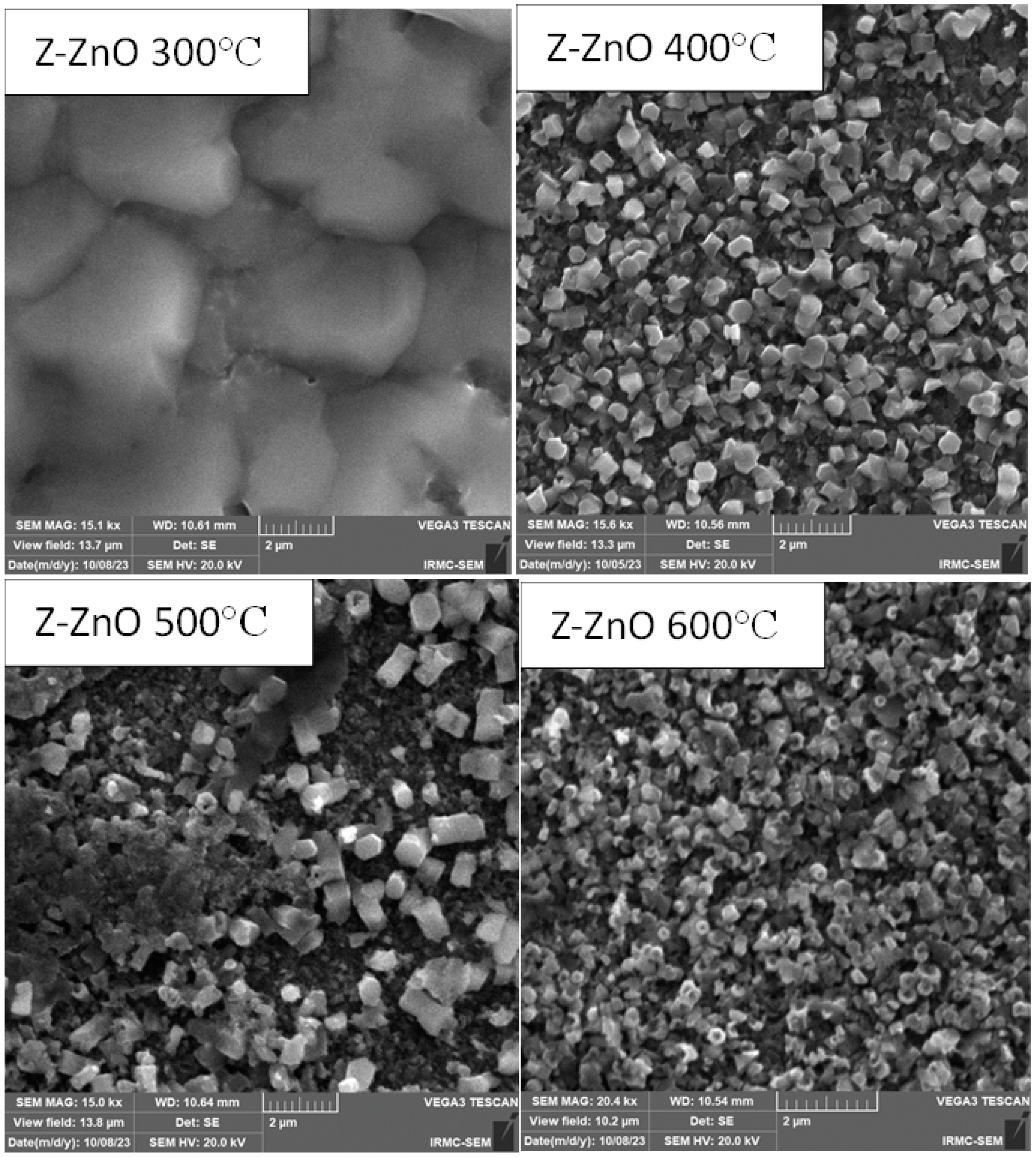
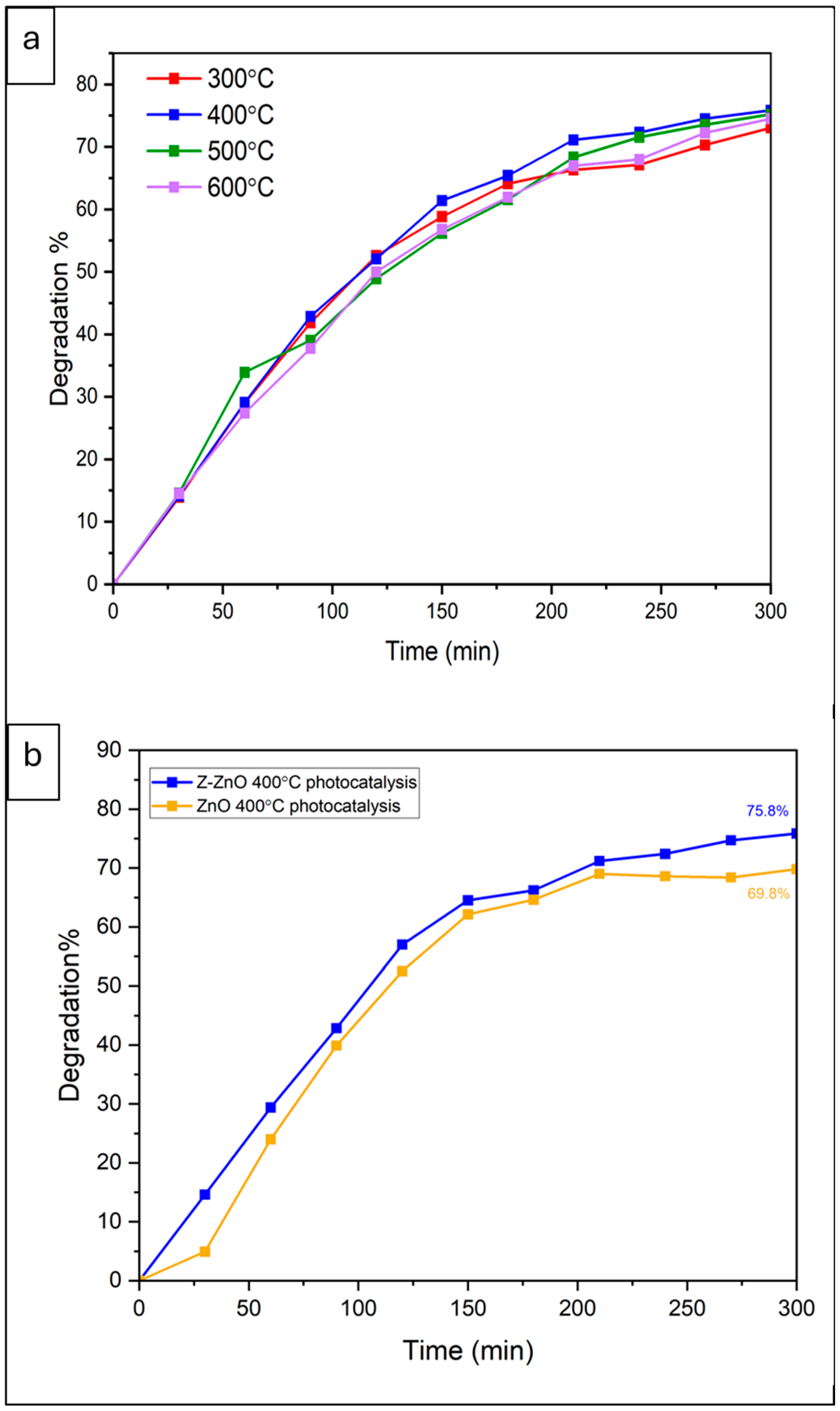
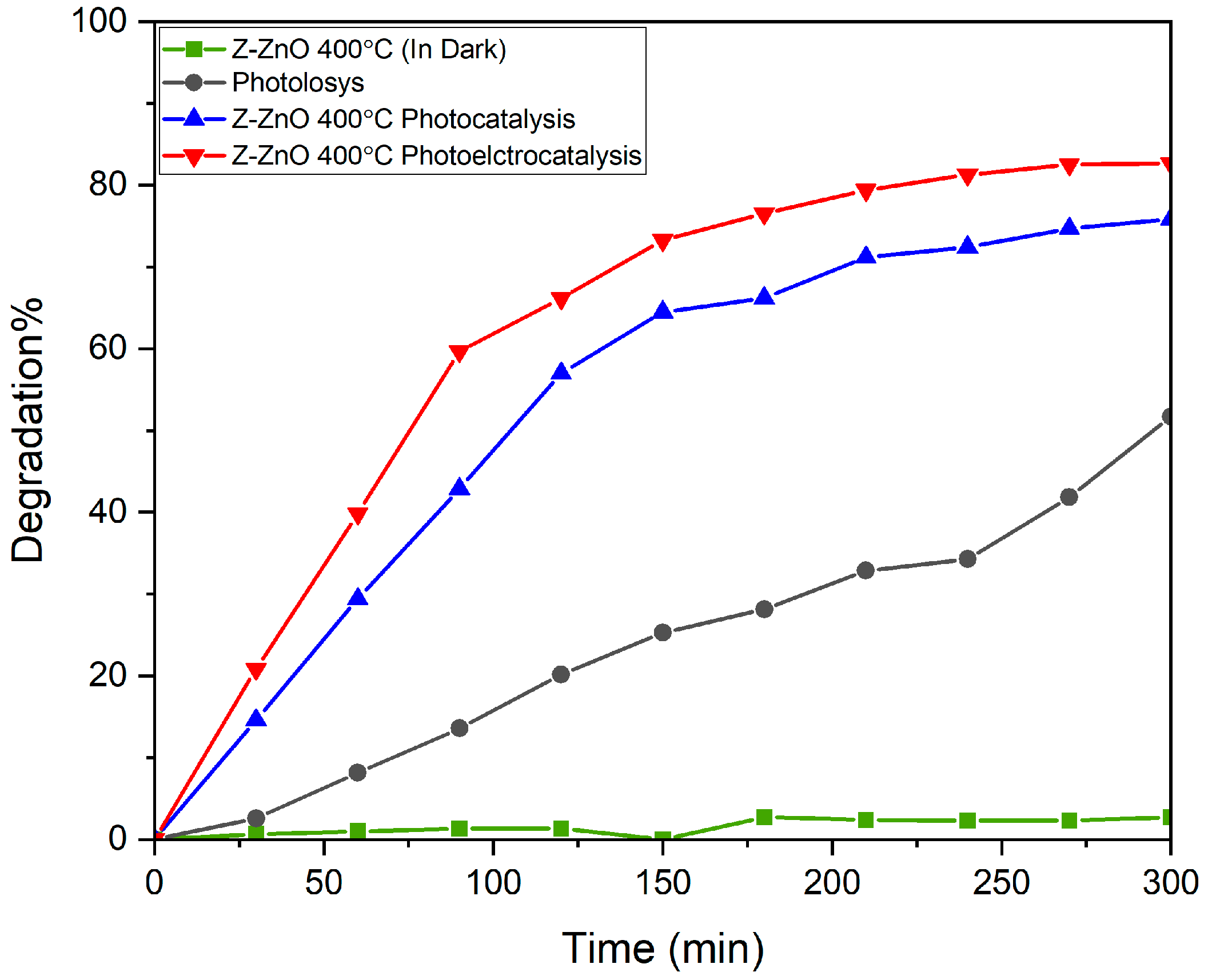

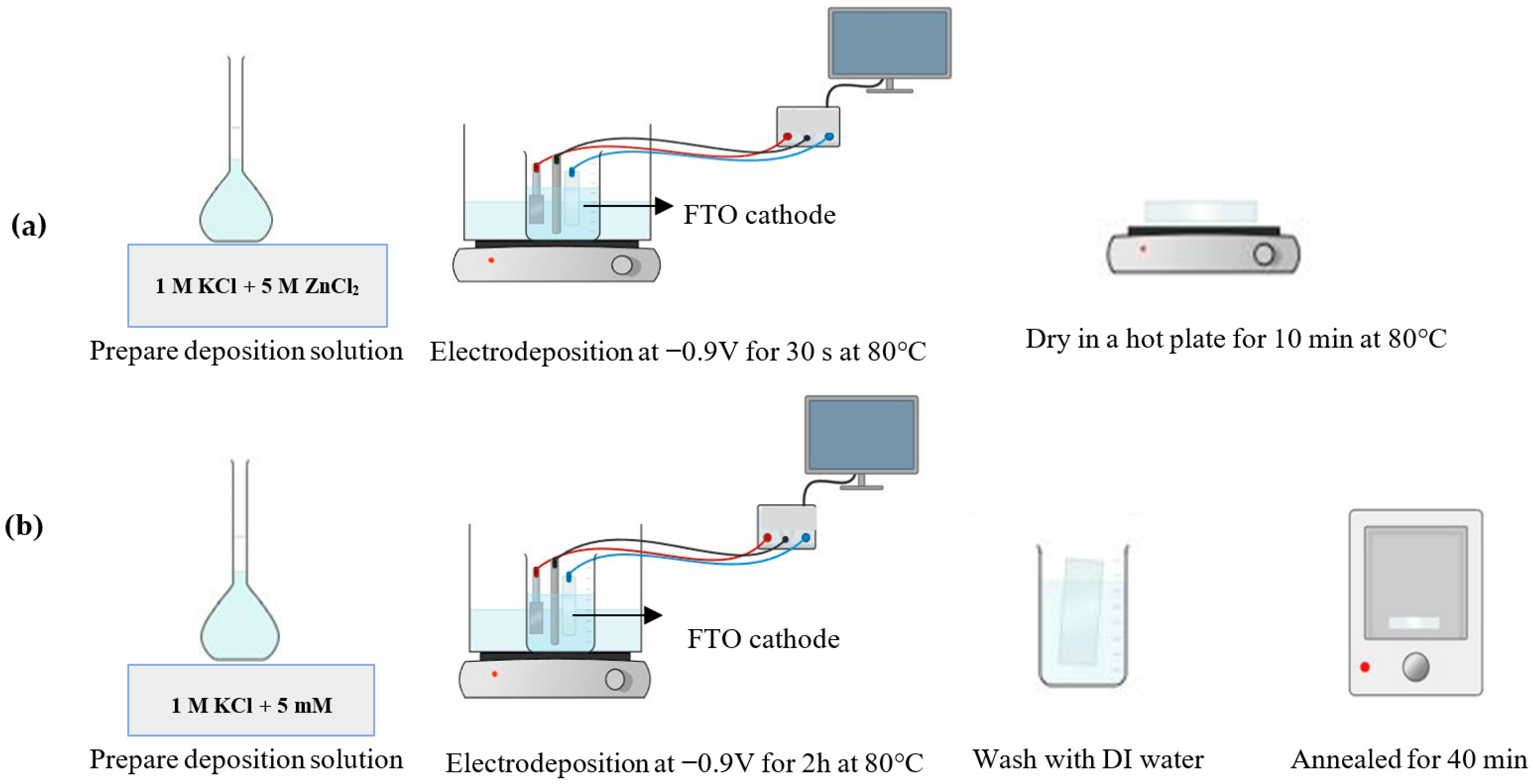

Disclaimer/Publisher’s Note: The statements, opinions and data contained in all publications are solely those of the individual author(s) and contributor(s) and not of MDPI and/or the editor(s). MDPI and/or the editor(s) disclaim responsibility for any injury to people or property resulting from any ideas, methods, instructions or products referred to in the content. |
© 2025 by the authors. Licensee MDPI, Basel, Switzerland. This article is an open access article distributed under the terms and conditions of the Creative Commons Attribution (CC BY) license (https://creativecommons.org/licenses/by/4.0/).
Share and Cite
Wazzan, G.M.; AlGhamdi, J.M.; Mu’azu, N.D.; Kayed, T.S.; Cevik, E.; Elsayed, K.A. Annealing Temperature Effects of Seeded ZnO Thin Films on Efficiency of Photocatalytic and Photoelectrocatalytic Degradation of Tetracycline Hydrochloride in Water. Catalysts 2025, 15, 71. https://doi.org/10.3390/catal15010071
Wazzan GM, AlGhamdi JM, Mu’azu ND, Kayed TS, Cevik E, Elsayed KA. Annealing Temperature Effects of Seeded ZnO Thin Films on Efficiency of Photocatalytic and Photoelectrocatalytic Degradation of Tetracycline Hydrochloride in Water. Catalysts. 2025; 15(1):71. https://doi.org/10.3390/catal15010071
Chicago/Turabian StyleWazzan, Ghaida M., Jwaher M. AlGhamdi, Nuhu Dalhat Mu’azu, Tarek Said Kayed, Emre Cevik, and Khaled A. Elsayed. 2025. "Annealing Temperature Effects of Seeded ZnO Thin Films on Efficiency of Photocatalytic and Photoelectrocatalytic Degradation of Tetracycline Hydrochloride in Water" Catalysts 15, no. 1: 71. https://doi.org/10.3390/catal15010071
APA StyleWazzan, G. M., AlGhamdi, J. M., Mu’azu, N. D., Kayed, T. S., Cevik, E., & Elsayed, K. A. (2025). Annealing Temperature Effects of Seeded ZnO Thin Films on Efficiency of Photocatalytic and Photoelectrocatalytic Degradation of Tetracycline Hydrochloride in Water. Catalysts, 15(1), 71. https://doi.org/10.3390/catal15010071







